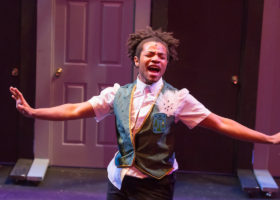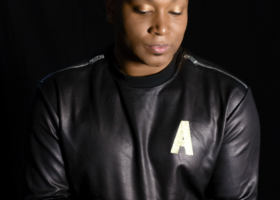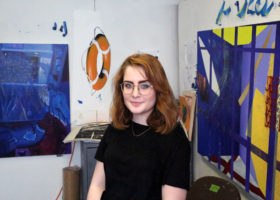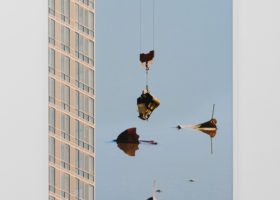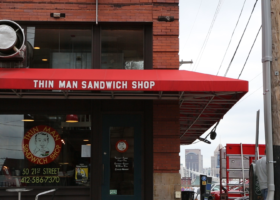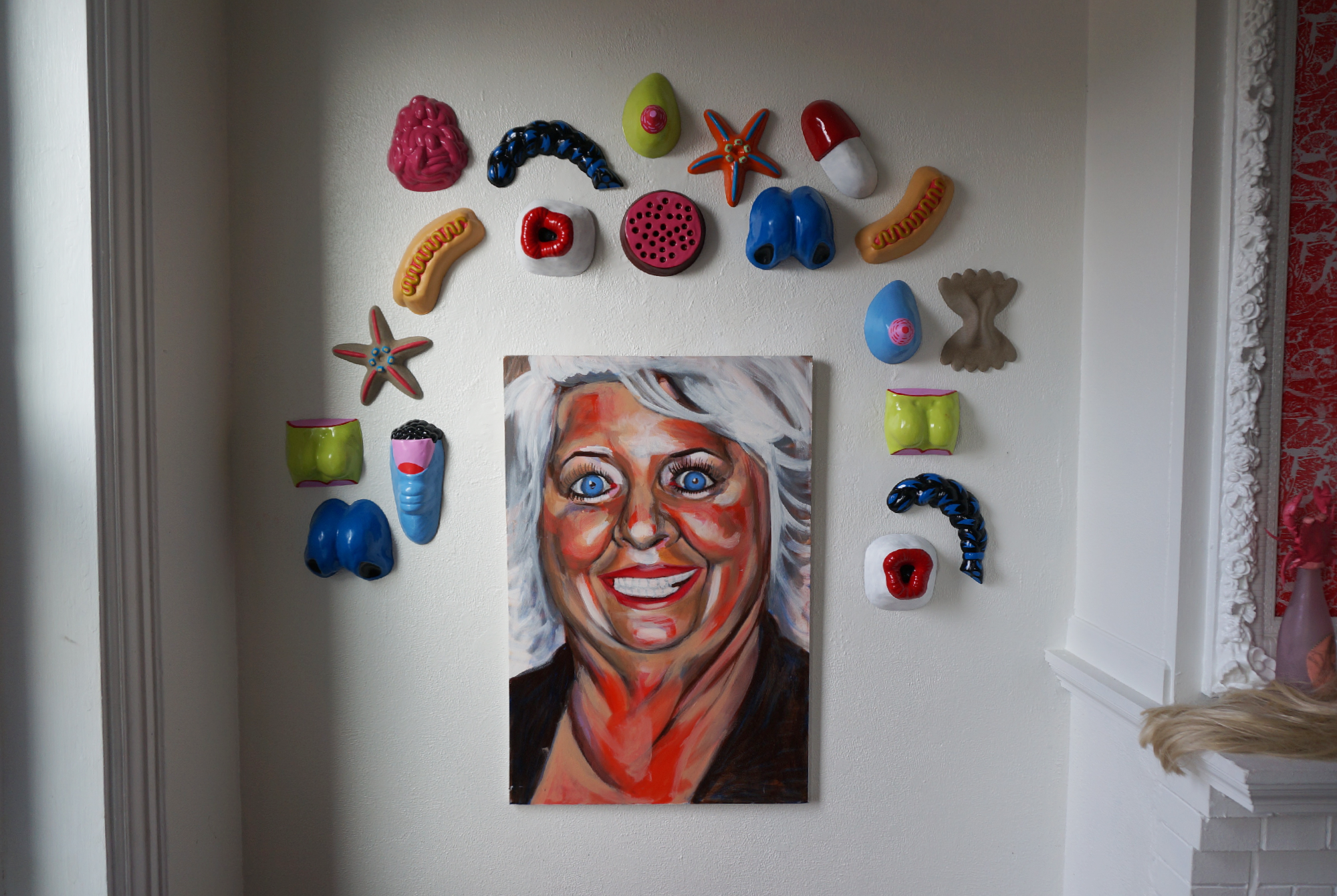
Bunker Projects is “so supportive of their artists and residents,” Lizzee Solomon told me as I sat down with her and Christina Lee for a conversation about their dual exhibit SHART SHOW at the experimental gallery in Garfield. “No other place has been as accommodating in catering to the needs of an artist, in terms of promoting, or helping hang the show, lighting it, hyping it to people coming into the gallery space. And they continue to have really stellar programming.”
Add to that list of stellar programming SHART SHOW, which opened last week during the neighborhood’s Unblurred: First Friday crawl. In the cozy second floor gallery, portraits of leering, luridly rendered daytime television celebrities like Dr. Phil and Paula Deen hang alongside arrays of fluorescent, glossy baubles: hot dogs, starfish, boobs, butts, and a smattering of unidentifiable orifices. A wall papered in raw-red, meat-veined prints sets a rich backdrop to a coil of sculpted, glittery shit that, rather than disgust, evokes a smiling emoji character. While SHART SHOW dips into the comically, exuberantly gross in concept, it is also a showcase of technique and a shared vivid aesthetic, as I learned in conversation with Solomon and Lee. We discussed their work (and selling it), their art school experiences, and Pittsburgh’s rich comic illustration scene—read a lightly edited transcript below.
![]()
Adam Shuck: Tell me a little about how you two came together for this dual show.
Lizzee Solomon: I know a few of the people involved in the Bunker Projects, one of whom is Anna Nelson, who was, I think, in the same year as Christina at CMU in the School of Art; I was in the class two years ahead of her. [Christina] did illustration and comics work too, and that was kind of rare—not a lot of people were doing that, so we kind of bonded together over it. Originally Anna had offered the show to me with the pretext of, “And another person if you’d like,” and Christina was the first person who came to mind.
AS: At CMU, how much were you two working alongside each other?
LS: Not a lot. Unfortunately, the classes at CMU are [such that] once you’re in your junior and senior year, you’re pretty much just in your studio, not really taking classes per se. So because we were two years apart we weren’t in very many classes together, if any. But we would hang out in each other’s studios and stuff.
AS: You both came to Pittsburgh for CMU, and you both were in the Studio Art program. How much of your style and your work were already formed when you came to art school, and how much was influenced or directed by that experience?
Christina Lee: When I was in high school, I was already making pretty grotesque works of art. I remember making an oil painting of a very large lady in an American flag bikini when I was a senior in high school, so I already had this kind of crass sense of humor. That one was actually one of my portfolio pieces for entry to CMU. I think CMU has helped me in a lot of ways expand my range in mediums. I got to learn how to do screen printing; I learned a little bit more about painting. The curriculum also forces you to experiment with a lot of new mediums you wouldn’t necessarily [be exposed to] if you were in another fine art program at, like, Pratt or RISD, where you select your major your first year. [At CMU] I had to do performance art, video art. I got to do a lot of animation. I got to play around with a lot of things, and then my senior year focus on the mediums that I liked the most, which were painting, printmaking, and animation.
AS: So [CMU] gave you a menu of technical skills, say, but not necessarily—I mean, you came in [as a first-year student] with a portfolio piece, like you said, that was grotesque, which I can directly associate with what I’m seeing here.
CL: I would say I’m a little bit of an anomaly because most of the other students that I know have actually grown a lot more conceptually versus technically. I think one of the big criticisms of the School of Art is [that] it doesn’t offer a lot of technical training in terms of depth—
LS: Yeah, it was [more like], breadth.
CL: Lizzee and I are both very technically-driven artists, so we chose our things and stuck with them and made every single project with our selected favorite mediums.
[I ask Lizzee about her her wall-mounted sculptures].
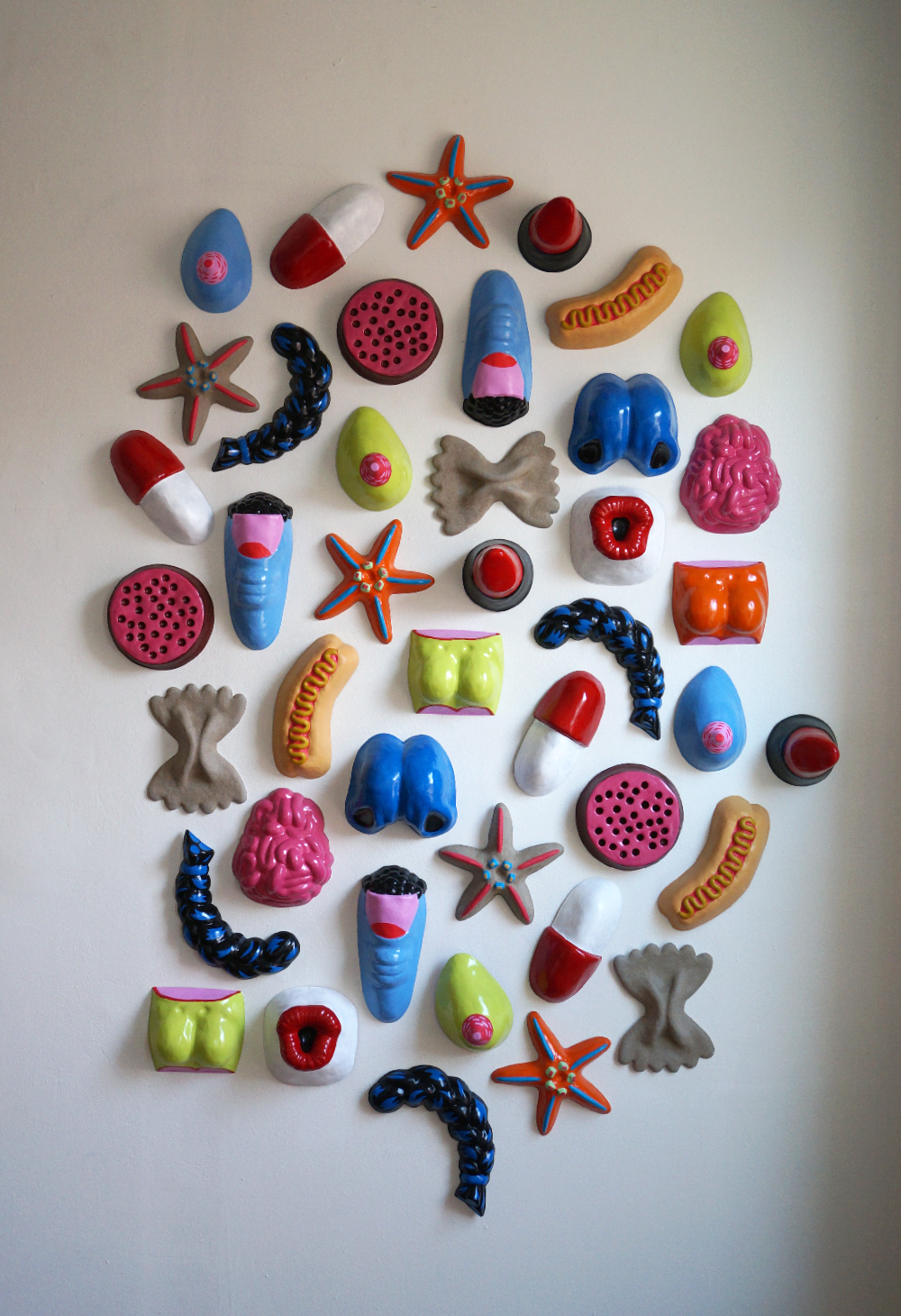
LS: The original forms, they’re based on objects that I think are alluring or interesting or silly, like the farfalle pasta, which was one of the first ideas that came to mind. The only filter I had was, will it work technically with the machine? Because in order for a form to work, it has to be sloped at a certain angle; it can’t be protruding too much. Vacuum forming in general is kind of a newer technology to me. I only started doing it a year and a half ago at TechShop. It’s pretty much like printmaking plus sculpture.
AS: Have you found that your more sculptural pieces, like your earrings or these smaller sculptures, are totally different from your zines or illustration in terms of marketing or selling? That is, do they sell better?
LS: I still have a lot to learn about marketing my artwork versus marketing zines, which—that’s pretty straightforward: You make a zine and then you exhibit it at an expo like the Pittsburgh Zine Fair or PIX Indie Comix Expo. You have it online; you might have it in some stores. But once you’ve made it and published it, it kind of sells itself after a certain point, as people expect you to release new issues every once in a while. I feel that people want to purchase artwork but they don’t have a lot of disposable income to do so. Like, people aren’t necessarily looking to buy thousands of dollars worth of art for their living room, but they want to buy something that’s $100 or less, so I try to make stuff that is in that price range.
I also like to make a lot of things, I like to repeat things a lot, so I view it as a production process rather than investing in a large painting that you might want to sell for $10,000. [With the vacuum-formed sculptures], it’s not going to break the bank to make, and it’s also accessible for people to purchase. The earrings came out of having a lot of excess material from the laser-cutting, so that was a sort of spontaneous thing. But I really like doing that. I’ll probably make more of them.
AS: Christina, tell me about your illustration work.
CL: I have some zines here, and I have some screen prints. I’ve been mostly working on spot illustrations for magazines, or commissions to do band or event flyers. I’d prefer to have more illustration jobs, but right now it’s more just a matter of what people need and who my connections are—mostly people who are throwing events and not necessarily people who own publications.
AS: Lizzee, you shared this John Waters quote that is associated with your whole style, but which you’ve also brought into this show: “To me, beauty is looks you can never forget. A face should jolt, not soothe.” Is your point to explore beauty—or whatever the opposite of beauty would be? In being familiar with your work, I wouldn’t necessarily say it’s “beautiful.”
LS: Yeah, I think that quote represents more my illustration work than the work in this show. In this show, the objects in particular, I find those things attractive. I don’t find them ugly—but they’re kind of neither ugly nor beautiful, they’re just common items. They’re silly, they look like they’re Lucky Charms or something. Whereas the illustration work, like the Food Girl series that I do, that’s more explicitly related to beautifully-rendered ugliness. I like the look of crisp, clean line work and colors that are contrasting, not a lot of gradients, just a really graphic style. But making folds of fat and wrinkles and veins in your eyes as the main player in the composition. I hope that that came out a little bit in this work, but I was also just experimenting with color and technology. But, yeah, I think ugly and silly things can be beautiful too.
AS: Ugly, silly, but also, like, carnal. Not sexy, but sexual. Graphic. And mixing food and sex. [In the sculptural pieces] there are butts, there are unidentified genitalia-like figures.
LS: Yeah, a lot of people saw dicks and butts where I didn’t even necessarily see them. I guess that’s a good sign.
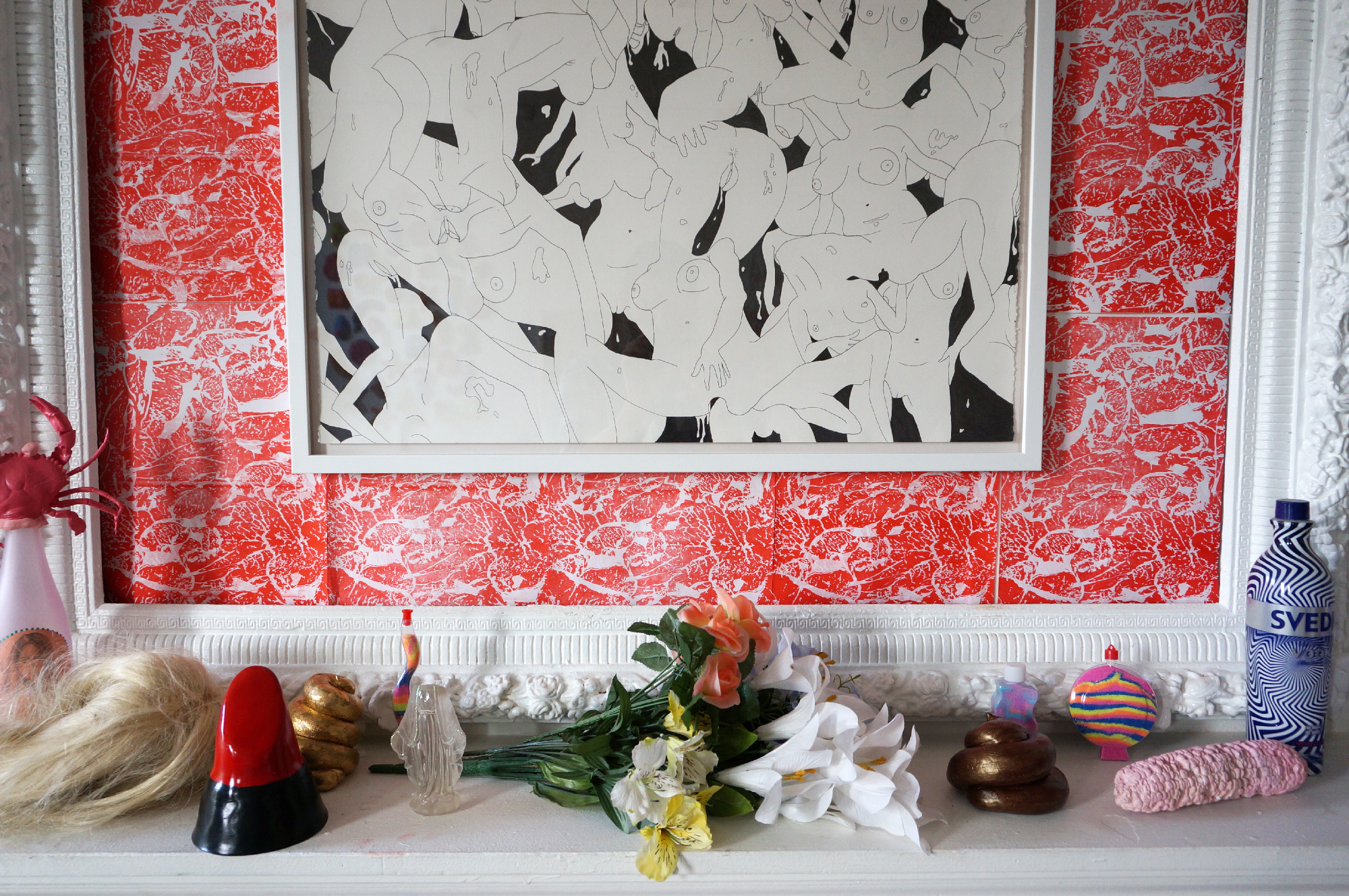
AS: Christina, where would you say your work converges with Lizzee’s?
CL: I think it’s the fact that we’re both technically-driven. And I think there’s a similar aesthetic that we’re both attracted to: We both have this fascination with design and bright colors and making things look objectively nice so that it’s pleasing to the eye. But we also have this fascination with the grotesque. I like it when people view my work and they’re like, “Uhhh, what is that?” or they just laugh at it. Which is why I went into zine making for the first time, because I could really elicit that kind of response with some of the comics I was producing.
One of the prints is made from the sketches Lizzee created for her vacuum forms, so that’s one discrete way that you can see our work is similar. The way I met Lizzee was: It was my freshman year at CMU, and I was feeling so alienated from the program because it was a fine arts program and not so much a visual illustration program. And then I met this really cool junior named Lizzee, and she was making all these cool zines. I think we met at PIX for the first time? [Lizzee nods]. I sold my zines for the first time there. It was probably one of the best learning experiences I ever had in college. Just having someone passively look at your work in a gallery versus sitting behind a table of your work and having people actively walk by and come up to you and talk to you about it. It’s a much different experience, and you learn a lot more about marketing yourself, what sells at a PIX crowd, or what sells at a Pittsburgh Zine Fair crowd.
LS: Yeah, those are different sometimes. [She laughs]. I think [the experience of selling at a zine fair], in the midst of spending most of your time in a studio or in a critique with people you see everyday, your professors and peers—for me it was one of the first forays into, like, real Pittsburgh, real things happening for artists in Pittsburgh. CMU is getting better and better at this each year, but there’s still a lot that can be done for students to push them out of their classroom comfort zone, and be like, this is happening in this city that you go to school in, and you should be a part of it too. I think some people are a little unaware of what’s going on in Pittsburgh even by the time they’re seniors. So it was cool to be able to meet people interested in that kind of niche market, zines, because that was something that wasn’t necessarily encouraged to be made at CMU—though there were some cool professors who were actually pretty down with it.
AS: Say you two didn’t know each other in order to collaborate on this show—I’m curious who some of the other Pittsburghers doing similar work are whom you would have partnered with?
LS: I’d say among the first people I met outside of the CMU who were making zines was Andy Scott. He used to do Andromeda Quarterly, and he published them all into an anthology [of] Pittsburgh comic makers, [as well as] people from Columbus and around the region. And those are available at Copacetic Comics for sure and probably other places. Also, Steph Neary.
CL: Her work is great.
LS: Yeah, she’s incredible. She doesn’t do a lot of zines currently, but her illustrations and her mixed-media sculptures, which are all really figurative and really folk-y: portrayals of women and mother figures, or really childlike doll people, this whole world that she’s made that’s consistent through all her mediums. And seeing another woman doing that kind of stuff was really inspiring. Because you kind of think, OK, comics expo: lots of dudes. And it is kind of like that to an extent, but there are a lot of girls in Pittsburgh doing noteworthy stuff.
CL: I’d also like to mention Juan Fernandez, who’s a spectacular comic book illustrator. He owns one of the few risograph printers in Pittsburgh and he’s involved with Frank Santoro in creating a comic residency program. They’ve been doing funding for it with Bill at Copacetic.
LS: Pittsburgh is becoming a comics destination. I feel like it already is in a lot of ways, and if you’re already in the world of it, you know there’s so much talent here. That residency that’s happening, and the Pittsburgh Zine Fair getting larger and larger each year. PIX is the comics-specific fair, and that’s getting bigger every year too.
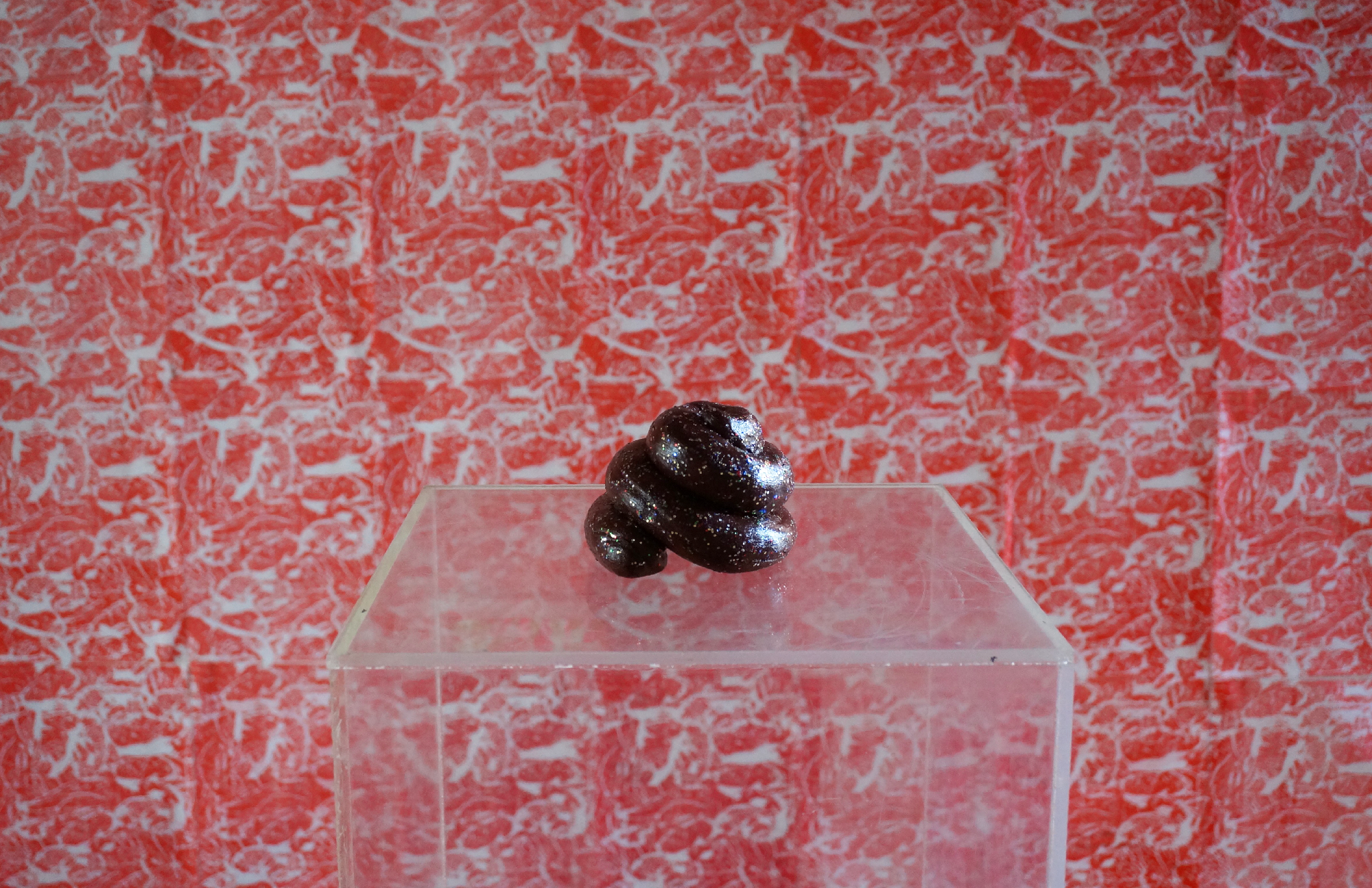
AS: In both of your work, there’s a child-like sense that comes through. There are bold colors, there’s this humor, this playfulness. There are poop sculptures. What do you think about the idea of your own childhoods influencing your work today, or your drawing upon your childhood of cartoons and the early days of the internet?
CL: Yes. I sculpted those poop sculptures in high school, and I decided to revisit it for this show because I thought it would be fun. But yeah, I think I spent most of my childhood eating colorful sugary cereal and trying to get up at six in the morning to watch Saturday morning cartoons and Sailor Moon. I was an avid anime fan. Dance Dance Revolution. I went through a video game nerd phase. I was on Avatar Palace, on the internet when I was way too young, faking my age on a bunch of message boards, reading some web comics. I tried to make my own illustrated fantasy book when I was in third grade, with my own persona inspired by these Pokemon comics I read. I think it all feeds into my art. I’ve always been a little bit of a culture vulture. I consume culture incessantly. I’m always on Wikipedia. So the fact that I’ve depicted these pop culture icons, and the imagery illustrated in my prints—it’s all reminiscent of pop culture in general, which has been an interest since I was very young. And I don’t think I’d be that obsessed with culture if the internet didn’t exist. I might be interested in something more worthwhile, like history.
[Laughs]
LS: I think in terms of growing up as teenaged girls, we’re also force-fed a lot of media, and at least for me, I don’t think it was necessarily a choice to see a lot of stuff, but I think that shows that I continue to be interested in it, as an adult woman—like tabloids, reality TV, things like that—[are a choice]. I think a lot of the stuff that we both do is inspired by nostalgia and this kind of idolization of certain figures, but it’s rendered in our own palettes, which has definitely evolved over the course of going through school and since making our own artwork with new technologies. Like, Christina, you weren’t using the risograph to make prints at CMU, but the risograph lends itself really well to the stuff you were making, like repetitive forms and shapes. [This repetition] is another common ground in our work. The repetition of things [can render them] into sacred objects, [but] it also dilutes into just plain aesthetic. Like, you could stand back 100 feet from this wall and you wouldn’t know [that print] was meat. But as you come closer, you could see all kinds of things in the detail, be reminded of a lot of things surrounding your memories of meat, very visceral.
CL: [Also there’s] the idea of the pattern being related to excess and getting your mind taken over by culture or the internet or whatever TV shows we were watching.
AS: Tell me about the Grin and Bare It: Grotesque Figure Drawing event on Sunday.
LS: We’re going to definitely do a lot of the traditional trappings of a figure drawing session that you would see in art school: nude person, some poses to get warmed up. We’re encouraging people to work large, with newsprint and charcoal, so you don’t get too attached to your drawings.
I remember in school I got chastised a lot for spending too much time drawing the dick or the knuckles because that was what was interesting to me. I had a professor who ripped something in half, and I was like, “Oh my god!” We’re not going to do that, but [we definitely want to] get people loosened up and focusing on observing and simultaneously drawing in a quick time frame. And then, for caricature, it will be another way of observing that’s less true to form. Like, here’s how to look at someone’s face and identify the defining characteristics that you need in order to draw a caricature of someone.
CL: We’re more familiar with the traditional style of figure drawing, but I think we’re going to find ways to incorporate the grotesque into this traditional form to make it a bit…
AS: Shartier?
CL: Yes, shartier.
![]()
SHART SHOW‘s Grotesque Figure Drawing session takes place on Sunday—learn more information on the Facebook event page here. SHART SHOW will also be holding a closing reception, featuring Korean BBQ and animation screenings, on May 27.
